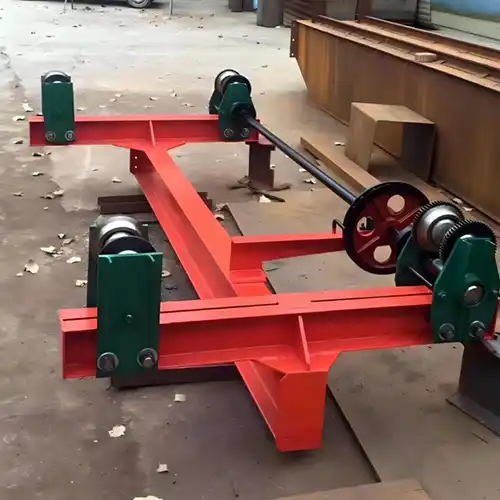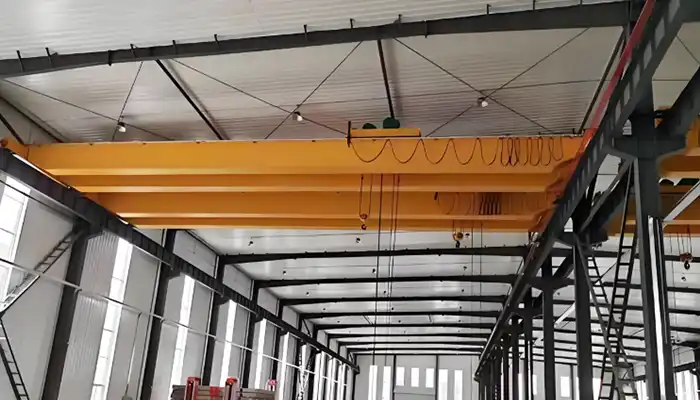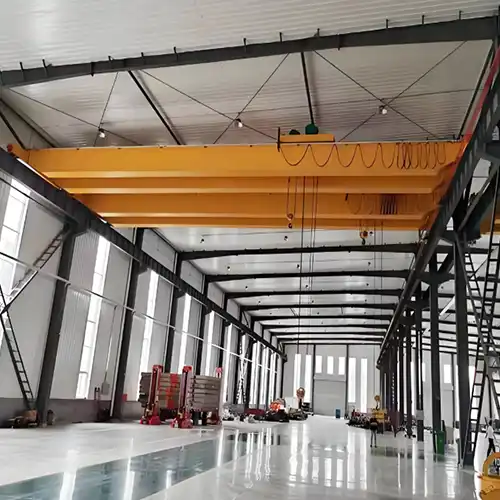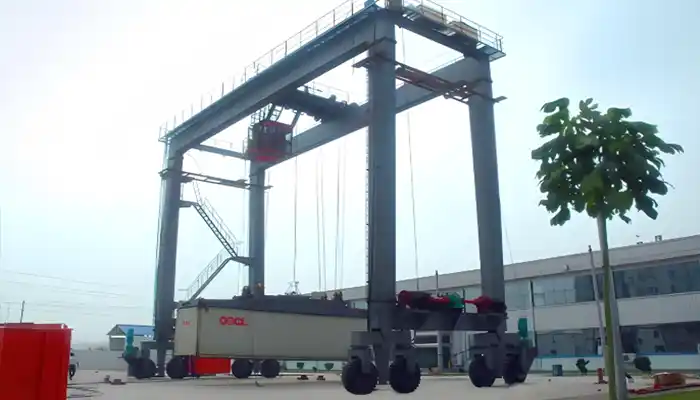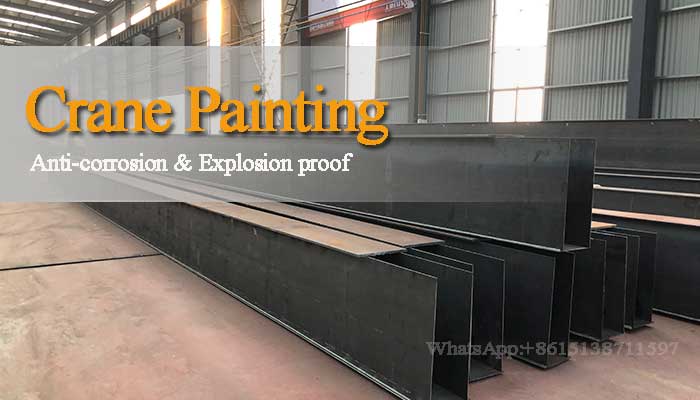
Crane Painting & Crane Coating All You Want to Know
To prevent corrosion and extend the operating life of overhead travelling cranes and gantry cranes, priming painting, intermediate coating, and finish coating are required. Crane coating paint can be customized. Yellow, Red, Orange, or Blue, which do you prefer?
General requirements of the crane coating thickness
When manual and powered dedusting are used, two priming and two fish coat are frequently required for components that have common requirements for crane coating.
When using a jet blaster, it is preferable to paint the primer two times, the intermediate lacquer one to two times, and the final coat two times for components with greater crane coating needs.
Thickness of the crane coating
The thickness of the crane coating is very important when choosing the correct crane coating. If the crane coating is too thin or uneven, it will develop pinholes, causing the steel to corrode and develop a rusty bulge that will progressively increase, eventually causing the crane coating to fall off. If the crane coating is too thick, it will improve protection but diminish adhesion and mechanical qualities, as well as increase expenses.
The entire dry film crane coating thickness must be at least 120m (mild erosion), 150m (moderate erosion), and 200m (severe erosion) (an important component of a strong erosion). To obtain a good anti-corrosion effect, the layer thickness should be even, continuous, and without pinholes.
Factors affects crane coatings
Surface treatment, which accounts for 60% of the service life of crane coatings, coating construction, which accounts for 25% of the service life, and coating quality, which accounts for 15% of the service life. Every link in the construction has a direct impact on the coating effect.
Surface Treatment
- Blow-dry or degrease the metal surface using compressed air and washing solvent if there is water, oil, or dust on it prior to rust removal.
- Remove rust, oxide skin, sludge, welding slag, and splash, as well as other contaminants. (It is permissible to remove the little amount of iron oxide skin that is difficult to remove by shot blasting and manually remove the remaining oxide skin.)
- The metal surface should be properly blasted clean with compressed air after rust removal.
- Before painting, the steel structure that is exposed to the air should be sandblasted or shot blasted (the plate thickness is less than 6mm by jet cleaning, manual and power tools to remove rust, which is easy to deform, it is better to choose acid washing and rust removal method). The surface roughness reaches 4080m after rust removal.
- Clean up the metal surface after rust removal and apply antirust primer as soon as possible.
The following notes are made to the class codes described in the text.
Sa2 Class 1/2: Very thorough jet cleaning. The surface should be clear of visible oil, grease, and grime, as well as oxide, rust, coatings, and other pollutants when examined without magnification. Contaminants should only show up as spots or streaks of light discolouration if they are still present.
St2 Grade: Thorough hand and power tool cleaning. The surface should be devoid of visible oil, grease, and grime, as well as poorly adherent oxide, rust, coatings, and foreign contaminants when examined without magnification.

Preparation Before Painting
- To assist surface treatment and painting, as well as quality inspection, the building site should have sufficient and safe access, good lighting, and ventilation.
- Before painting, each portion of the crane should be cleaned, and preventive measures should be implemented based on the equipment parts' characteristics (parts not painted: nameplate, machining surface, cylindrical surface of brake wheel, gear teeth, should be coated with grease or wrapped with plastic before painting).
- The metal surface that will be primed must be dry, with no dew frost or moisture layer.
Steps of crane coating
- 1The primer must be sprayed in a clean and dry environment with a minimum ambient temperature of 5°C and relative humidity of 80–85 percent. When working outdoors, it is prohibited to spray (brush) the primer in direct sunlight, rain, fog, or sandstorm.
- 2. Apply the primer once according to the product's technical requirements; if it is required to apply the primer again, do it only after the first primer has dried; the general drying period is 24 to 48 hours at 18°C to 23°C.
- 3. The topcoat must be dry after the primer has been applied (24–48 hours at 18°C–23°C).
- 4. Before painting the topcoat, the oil and dust on the primer's surface must be removed to obtain a clean surface (after degreasing, the surface should be dried at 18°C23°C for 0.20.3 hours) and no moisture, dew frost, or moisture layer must be present.
- 5. Painting should be done when the relative humidity is 40–70% and the temperature is 12–25°C, and it is forbidden to brush or spray paint under the searing sun, wind, or sand when working outdoors.
- 6. If you wish to paint twice, wait until the first coat is dry before applying the second top coat (drying time is 24 hours at 18°C23°C).
General Technical Requirements for Painting
- The primer paint on the metal surface should adhere well and resist corrosion.
- To ensure that the film is even, flat, and smooth, two ways are permitted: brush paint and spray paint. Spraying equipment and pressure must match the requirements of the product specification.
- The product's paint surface must be firm, flat, smooth, and uniform in color, and the appearance of the paint film should not allow flowing, peeling, and obvious orange peel should be thoroughly checked before packaging, with film adhesion in accordance with GB/T 9286-1998 as one of the requirements.
- Within 4 hours of surface treatment, the suitable paint should be applied to the surface to be painted.
- The paint film's surface must be even, with no open bottom, pinholes, wrinkles, leaking, cracks, or other defects, and it must be significantly hanging.
- Paint film thickness in the dry state: The paint film must be of the prescribed thickness in the dry state. The equipment must be painted in accordance with the technical agreement's specifications. To remove faults such as scars, the damaged part must be recoated.
Painting procedures are precisely proportioned to the paint qualities and carried out according to their established process specifications.
Crane primer painting and finish coating
The most frequent way is to coat the corrosion protection layer to the steel surface, which is based on the electrochemical concept of steel corrosion. There are three types of corrosion protection layers that are commonly used:
- Electroplating, plating, electroless plating, hot dip, and other methods are used to coat a layer of metal on the steel surface.
- Chemical protective layer: Chemical or electrochemical procedures are used to cover the steel surface with an anti-corrosion chemical compound film.
- Non-metallic protective layer: To protect the steel, a layer of crane coating is shelled out and sprayed on the surface of the steel, which is the most common approach.
Anticorrosive crane coating
Anticorrosive crane coating is currently the most widely utilized type of steel surface protection. The primer coat, intermediate coat, and final coat are the three layers of the anticorrosive crane coating, each with its own set of characteristics and functions. The three layers work together to create a composite crane coating that protects the steel from corrosion while also extending its service life.
- Primer coat: Zinc rich primer and epoxy iron red primer are two popular primer coats applied by paint.
- Intermediate coat: Glass flake epoxy paint and epoxy micaceous iron oxide are used to paint the intermediate coat.
- Finishing coat: Epoxy paint, chlorinated rubber coat, and polyurethane coat are the most common finishing coats.
How can you choose the correct crane coatings and paint when faced with a variety of options?
For your convenience, here are some pointers:
- The application's local climate and surroundings.
- The ease with which the construction conditions can be met.
- The use of anticorrosive crane coating layers to solve the problem.
- The painting's cost, durability, and toxicity, among other factors.
Explosion proof painting for overhead cranes
In terms of explosion-proof cranes, we have very specific painting requirements for explosion-proof overhead cranes. One of our clients has requested explosion proof painting, and we've included a sample for your consideration.
The following paints must be used:
- Dimercoat 9 primer (drt 75 microns)
- Amercoat 385 (drf 150 microns)
- Amercoat 450S (RAI 1004 OR 1018) (75 microns drt)
We can precisely satisfy our customer's expectations after speaking with our overhead crane engineer.
As for the paint , our customer needs totally 3 layer:
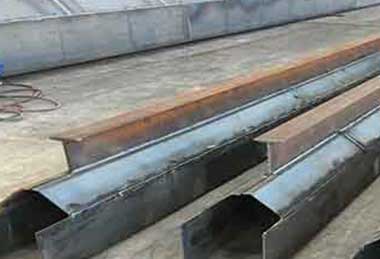
Crane girder without painting
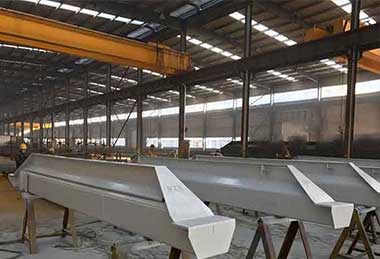
Primer coating of overhead crane
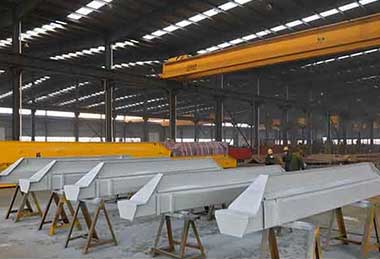
2nd layer of overhead crane
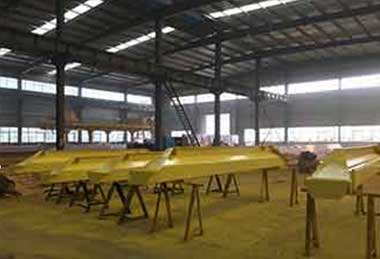
Top coating or finishing overhead crane coating
We will send an email to our customer at each stage of the crane manufacturing to keep them up to date on the progress and to make sure they understand the production timeline. They will have more faith in us once they realize what we do on crane quality control. If you have any question or doubt, please feel free to contact us.
Genral types of overhead crane pating & uses
Operating environment | Application environment | Coating thickness(μm) | Recommended paint varieties | |
Primer thickness | Total thickness | |||
General environment | Products used in inland area | 25-35 | 75-105 |
|
Coastal and highly corrosive areas | With salt-fog in coastal areas, industrial atmosphere with corrosion | 50-100 | 150-220 |
|
Hot environment | Products used in hot environment | 25-50 | 50-85 |
|
Strong corrosive environment | Products used in tide and humid conditions for a long time | 60-195 | 230-270 |
|
Environment with oil | parts contact with oil or box with oil medium | 25-50 | 80-160 |
|




